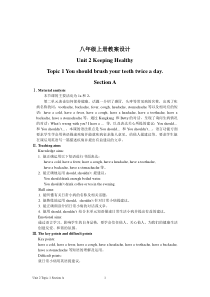 DOC
DOC
【文档说明】《Unit 2 Topic 1 You should brush your teeth twice a day》教案7-八年级上册英语仁爱(科普版).doc,共(4)页,34.500 KB,由小喜鸽上传
转载请保留链接:https://www.ichengzhen.cn/view-104935.html
以下为本文档部分文字说明:
Unit2Topic1SectionA1八年级上册教案设计Unit2KeepingHealthyTopic1Youshouldbrushyourteethtwiceaday.SectionAⅠ.Materialanalysis本节课的主要活动为1a和2。第二单元谈论如何保持健
康。话题一介绍了感冒、头疼等常见病的名称,出现了疾病名称的词:toothache,backache,fever,cough,headache,stomachache等以及相对应的短语:haveacold,haveafever,haveacough,haveahead
ache,haveatoothache,haveabackache,haveastomachache等。通过Kangkang和Betty的对话,呈现了询问生病情况的对话:What’swrongwithyou?Ihavea…
等,以及表达关心所提的建议:Youshould…和Youshouldn’t…。本课的语法重点是Youshould…和Youshouldn’t…。语言功能方面要求学生学会用英语描述疾病并能就疾病征求他人意见、给他人提建议等。要求学生能在课后用英语写一篇描述
疾病并提出有益建议的文章。Ⅱ.TeachingaimsKnowledgeaims:1.能正确运用以下短语进行书面表达:haveacold,haveafever,haveacough,haveaheadach
e,haveatoothache,haveabackache,haveastomachache等。2.能正确地运用should,shouldn’t提建议:Youshoulddrinkenoughboil
edwater.Youshouldn’tdrinkcoffeeorteaintheevening.Skillaims:1.能听懂有关日常小病的名称及相关话题。2.能熟练地运用should,shouldn’t针对日常小病提建议。3.能正确朗读介绍日常小病的对话或文章。4.能用should,shoul
dn’t结合本单元短语描述日常生活小病并提出有益的建议。Emotionalaims:通过语言学习,影响学生的自身品格,要学会信任他人、关心他人,为我们的健康生活创建友爱、和谐的氛围。Ⅲ.ThekeypointsanddifficultpointsKeypoints:have
acold,haveafever,haveacough,haveaheadache,haveatoothache,haveabackache,haveastomachache等短语的理解及运用。Difficultp
oints:就日常小病用英语提建议。Unit2Topic1SectionA2Ⅳ.Learningstrategies1.培养学生编对话的能力。2.培养学生提建议的能力。Ⅴ.TeachingaidsComputermultimediaprojecto
r,picturesofdifferentillnessesEverydaysaying:Bitterpillsmayhavewholesomeeffects.良药苦口利于病。Ⅵ.TeachingproceduresStep1Introduction(7minutes)1.Getstud
entsreadyforlearning.2.Chanttogether.Teachershowsthelyriconthescreenandsingsittogetherwithbodylanguage.3.Watchavideoandanswerthequestions1)What’st
herobot’sname?2)Whatdoestherobotdo?4.Theteacherleadstothenewtopic,“Yes,ifweexerciseeveryday,wewillbem
orebeautiful,strongerandhealthier.Ifyoudon’ttakepartinanysportsactivities,youwillbeilllikethechildrenhere.”Step2Presentation(10minutes)1.Teacherpr
esentssomepicturesaboutthenewwords:fever,cough,headacheandstomachache.Guidestudentstolearnthewordswiththephoneticsymbols
,showingtheverbphrasesunderthepictures.2.Teacherasksandanswersabout“haveafever”asamodelforthestudentstoimitate.A:What’sthematter?B:Hehasafever
.3.Teacherplays1cforthestudents.4.Teacherintroduces“What’swrongwithhim/her?”tothestudentstodopairwork.5.Teacherasksthestudentstopractice“
What’swrongwithyou?Ihavea…”inpairsaccordingto1c.6.Teacherasksthestudentstoaskandansweraccordingto1cingroups.7.Teacherasksthesixgroupstodo
chainpractice,andthefirstthreegroupswillwinthegame.Step3Consolidation(10minutes)1.Teacherleadsto1aforthestudentstofinish
1b,saying“BettyandKangkangaretalkingaboutillness.Let’slistenandfinish1b.First,youshouldlookthrough1bandmakesureyouknowwhattodo.”
2.Teacherplays1a,andthenchecksthestudents’answers.3.Teachercheckstheanswersandteachestheword“suggestion”bypointin
goutitssynonym“advice”.4.Teacherplays1aforthestudentstoreadwithoutstopping.5.Teachermakesaconclusion
,“Whenwetalkaboutillness,wemayuse—What’swrongwith…?—…have/hasa…”6.Teachershowspicturesofnewwordsonthescreen“coffee,tea,boiledwater”wit
hphoneticsymbols.Unit2Topic1SectionA37.Teacherexplainstheword“lift”bysayingitssynonym“carry”andasksthestudentstofinish2.8.Teacherchecksthestuden
ts’answers.Step4Practice(10minutes)1.Teacherasksthestudentstomakeupnewconversationsaccordingto1cand2.2.Teacherasksthegroupswhohavelostthegameofpr
acticing1ctopracticetheirnewconversationsinpairs.Eachgroupfinishesonepair.3.Teacherasksthebestpairtoshowtheconversationtot
hewholeclass.4.Teachershows“Youshould/Youshouldn’t…”ontheblackboard.Step5Production(8minutes)1.Makeadialogwithy
ourclassmateslikethis:A:Hi…What’swrongwithyou?B:Ihavea…A:I’msorrytohearthat.Youshould…B:IthinkIwill.A:Ihope…B:Thankyou.2.Teacherasksth
estudentstopresenttheirdialog.3.Teachershowsthesummarytothestudents.(1).Somephraseshaveacold,haveafever,haveacough,haveaheadache,haveatoothache,havea
backache,haveastomachache.(2).Somesentences1)What’swrongwithyou?2)What’sthematterwithhim?(3).Giveadvice1)Youshouldseeadentist.2)Youshouldn’tlifth
eavythings.4.Teacherassignshomework:(1).Recite1a.(2).PreviewSectionB.(3).Makeaconversationaccordingto1a.Ⅶ.TeachingReflectionIt’salitt
lehardforthestudentstogivepropersuggestionsonillness.Theymaysearchmoreinformationaboutthistopicafterclass.Ⅷ.BlackboarddesignUnit2T
opic1SectionA4Unit2KeepingHealthyTopic1Youshouldbrushyourteethtwiceaday.SectionAWhat’swrongwithyou?=What’sthematterwithyou?Ih
aveafever/cough/cold/backache.haveaheadache/stomachache/toothacheYoushouldseeadentist.drinkenoughwater/liftheavythings
 辽公网安备 21102102000191号
辽公网安备 21102102000191号
 营业执照
营业执照